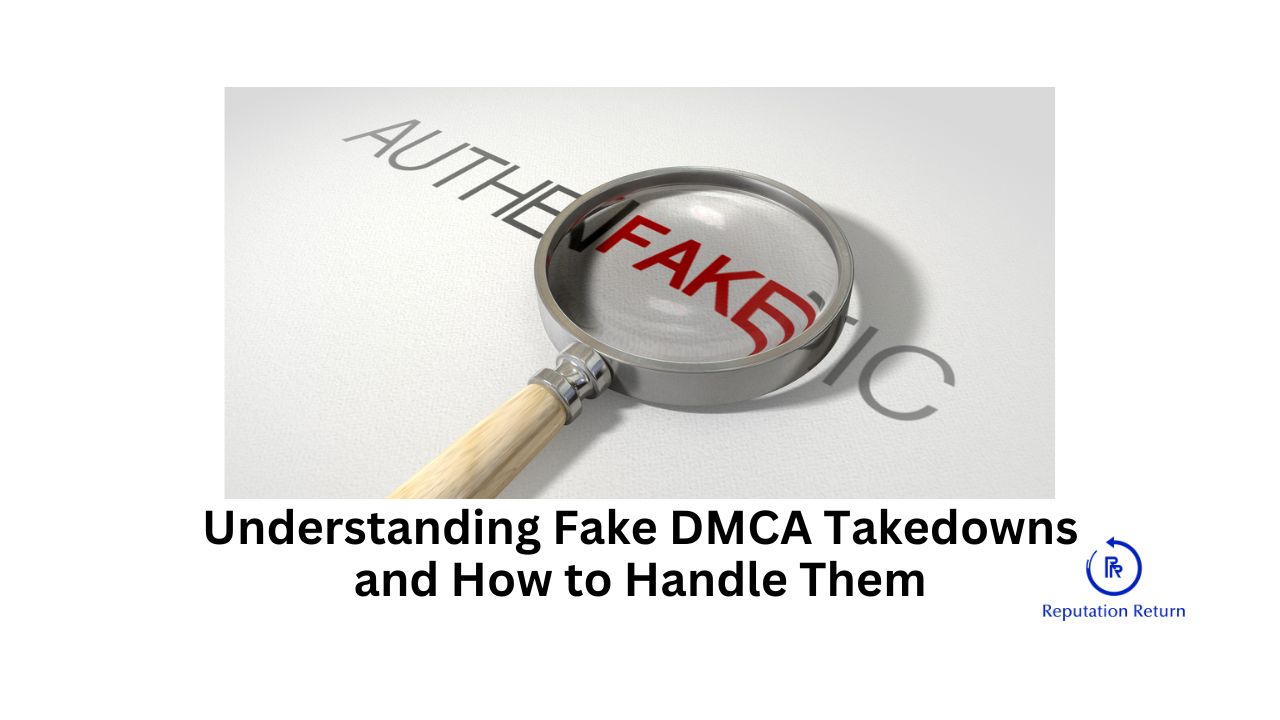The Digital Millennium Copyright Act (DMCA) provides a mechanism for copyright holders to protect their intellectual property online.
Unfortunately, this process is sometimes misused, resulting in fake DMCA takedown notices. These fraudulent claims can harm individuals and businesses by wrongfully removing content, damaging reputations, and causing financial loss. Understanding how to recognize and handle fake DMCA takedowns is crucial for protecting your online presence.
What is a DMCA Takedown?
A DMCA takedown notice is a legal request sent to an internet service provider (ISP), search engine, or website operator to remove content that allegedly infringes on the copyright holder’s rights. When a valid notice is received, the service provider is typically required to remove the offending content to avoid liability.
What is a Fake DMCA Takedown?
A fake DMCA takedown occurs when someone falsely claims that content infringes on their copyright. This can be done for various malicious reasons, including silencing criticism, harming competitors, or removing content for personal gain. Fake takedowns exploit the DMCA’s mechanisms, taking advantage of the system’s reliance on good faith reporting.
Recognizing Fake DMCA Takedowns
- Questionable Claimant Information
- Check the details of the claimant. Fake notices often contain vague or inaccurate information about the supposed copyright holder. Legitimate claimants usually provide clear, verifiable contact information and credentials.
- Unclear or Vague Copyright Claims
- Genuine DMCA notices specify the exact copyrighted work and how it has been infringed. Fake notices may lack these specifics or describe the alleged infringement in ambiguous terms.
- Unexpected or Unfamiliar Sources
- If the notice comes from an unexpected source or a party with no apparent connection to the content, it could be fraudulent. Verify the relationship between the claimant and the content in question.
- Suspicious Timing
- Be wary of takedown notices that arrive during competitive disputes or after contentious interactions online. These may be strategic attempts to harm your online presence.
Steps to Handle Fake DMCA Takedowns
- Verify the Notice
- Examine the notice carefully. Look for inconsistencies or red flags in the claimant’s information and the alleged infringement details. Cross-check the claimant’s credentials and copyright claims.
- Contact the Claimant
- Reach out to the claimant to request more information or clarification. Genuine claimants will typically respond with the requested details. Lack of response or evasive answers may indicate a fake notice.
- File a Counter-Notification
- If you believe the takedown is fake, you can file a counter-notification with the service provider. This formal declaration asserts your right to the content and requests its reinstatement. The counter-notification should include:
- Identification of the removed content.
- A statement under penalty of perjury that you have a good faith belief that the content was removed in error.
- Your contact information.
- Consent to jurisdiction in the relevant court.
- If you believe the takedown is fake, you can file a counter-notification with the service provider. This formal declaration asserts your right to the content and requests its reinstatement. The counter-notification should include:
- Seek Legal Advice
- Consult with an attorney who specializes in intellectual property law. They can provide guidance on handling the situation, filing counter-notifications, and potentially pursuing legal action against the fraudulent claimant.
- Notify the Service Provider
- Inform the service provider about the suspected fake DMCA takedown. Provide any evidence supporting your claim. Service providers often take such matters seriously and may assist in resolving the issue.
- Monitor for Recurrences
- Keep an eye on your content and be vigilant for further fraudulent takedown attempts. Maintaining detailed records of any previous incidents can help build a case against repeat offenders.
Preventative Measures
- Maintain Accurate Records
- Keep detailed records of your content creation process, including dates, drafts, and sources. This documentation can serve as evidence in defending against false claims.
- Watermark Your Work
- Watermarking images, videos, and other content can help establish your ownership and deter fraudulent claims.
- Use Trusted Platforms
- Host your content on reputable platforms that have robust DMCA policies and support systems. These platforms are more likely to assist you in dealing with fake takedowns.
- Educate Yourself
- Familiarize yourself with DMCA procedures and your rights as a content creator. Knowledge is your best defense against fraudulent claims.
Case Study: Overcoming a Fake DMCA Takedown
Consider the case of a small business owner who received a fake DMCA takedown notice for a popular blog post. Here’s how they successfully managed the situation:
- Verification and Contact: The business owner carefully reviewed the notice and identified discrepancies in the claimant’s information. They contacted the claimant for clarification but received no response.
- Counter-Notification: Confident that the takedown was fraudulent, they filed a counter-notification with the hosting platform, providing evidence of their ownership and detailing the inconsistencies in the claim.
- Legal Consultation: They consulted an intellectual property attorney who confirmed the notice was likely fake and advised on the wording of the counter-notification.
- Service Provider Notification: They informed the hosting platform of the suspected fake takedown. The platform investigated and reinstated the content.
- Monitoring: The business owner monitored their content for further fraudulent claims, ready to act quickly if necessary.
By taking these steps, the business owner successfully defended their content against a fake DMCA takedown, ensuring its continued availability online.
Fake DMCA takedowns are a troubling misuse of copyright protection mechanisms that can disrupt your online presence and damage your reputation. By understanding how to recognize and handle these fraudulent claims, you can effectively protect your content and maintain control over your digital assets. Stay vigilant, be proactive in defending your rights, and seek professional assistance when necessary to navigate the complexities of the DMCA process.
If a fake DMC a takedown is hurting your online reputation, learn how we can help you.

